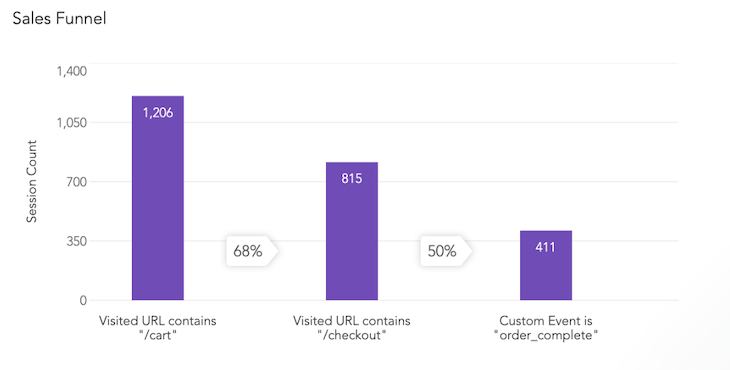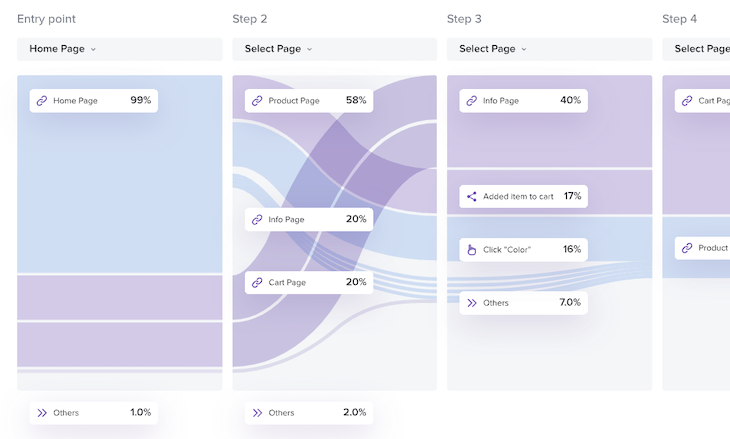Leveraging digital analytics is an absolute requirement for product managers looking to build the best products. The age-old saying, “You can’t fix what you can’t measure” holds true when it comes to leveraging data to make product decisions. Without this important data, you’ll have trouble understanding what areas of the product to invest in, whether or not the features you shipped are being used, and if you’re having an impact on the business.

In this blog post, we’ll cover what digital analytics is, how you should leverage it as a product manager in your organization, and how you should choose a tool that supports your digital analytics strategy.
Digital analytics is the practice of collecting and analyzing metrics that measure online engagement and activity. Although most people think of digital analytics as measuring website traffic, it can extend to product usage in mobile or SaaS applications as well.
Digital analytics typically includes event data, which essentially tracks things that happen when they happen. For example, website signups and product usage all count as types of digital analytics. It may also include demographic or firmographic information about a user, like the company they work at or what their job title is.
Digital analytics within the context of product management is helpful for understanding product usage. This is important data to collect as it helps product managers identify what areas of the product are most used so that they can further invest in those areas as needed. On the flip side, digital analytics can also help product managers identify features that are poorly adopted within the product. These features can either be sunset or further improved to drive more usage.
Although it’s critical for product managers to leverage digital analytics, data should not be the only input in product management decisions. Often, the decisions you make about what to build involve a combination of quantitative data like digital analytics, qualitative data like user interviews, and good old common sense. Relying on only digital analytics to make product management decisions will result in poor product decisions.
This is true for several reasons. First, not everything can be measured via digital analytics. You can’t measure features that don’t exist yet, so big, net new areas of investment aren’t always found in your analytics. Second, digital analytics measure observations, but don’t always tell you the root cause.
For example, you might observe that only 20 percent of customers reach the second stage of onboarding, but in order to understand why this is, you’ll have to dig in deeper. And again, not all answers lie in the digital analytics themselves. Just because your second step requires email validation, doesn’t mean that requiring email is the wrong thing to do. Instead, you have to dig in deeper to figure out why customers don’t want to validate their emails, not just do away with email validation altogether.
So what is the best way to leverage digital analytics as a product manager? I like to break this down by product development lifecycle:
During the ideation and roadmapping phase, you might think that digital analytics isn’t as important because there isn’t a product to analyze quite yet. However, digital analytics is still an important input as you can use it to identify gaps and validate any hypotheses you might have about what to build.
For example, perhaps your digital analytics tool shows you that many customers who fail to pay don’t use a certain feature. This is a good indication that you should update your user experience to drive more usage of that feature. On the flipside, you might have a hypothesis that users who don’t use a given feature are unlikely to fully adopt your product. You can use the product analytics to validate that hypothesis.
A tool that offers conversion funnel analysis is useful for identifying gaps and validating hypotheses. The below image shows how LogRocket visualizes a funnel, which you can configure on your own for your product’s specific needs. As you can see, this type of funnel graphic helps identify whether or not you have certain steps in your funnel that result in an unexpected drop in adoption:

The product development phase is when you should think about your digital analytics strategy and how you can set yourself up for success. Many digital analytics tools require you to collect data by embedding SDKs or other packages. This tooling needs to be set up during the product development process.
Even if you’re using a tool like LogRocket to auto-capture product events, you will want to define what metrics you want to measure prior to shipping your product. That’s so that you can ensure that once you ship your product, you’re well positioned to measure what matters. In fact, I like to include “success metrics” as part of product specifications that I write during the product development process.
After a product is released, it is critical to leverage digital analytics to measure whether or not you were successful as a product manager. The definition of success should be based on what you had defined as a KPI during the product development process. It’s very important to measure the success of product releases because you want to learn from both your successes and failures. If you measure your product releases, you’ll know where to continue focusing your efforts!
When looking into adopting a digital analytics tool, there are several core functionalities that you should keep in mind when choosing which tool to use:
| Functionality | Evaluation criteria |
| Data collection |
|
| Data visualization |
|
| Data collaboration |
|
When thinking through data collection, vendors like LogRocket support autocapture, which makes it easier for product managers to collect events they care about without continuous engineering support.
In terms of data visualization, visualizing conversion funnels and paths can help you understand how users typically adopt features within your product and diagnose specifically when they fall off:

Finally, thinking about data collaboration is critical as it allows you to share product metrics with different members of your team, as well as members of cross functional teams. Most SaaS offerings allow some form of collaboration, although more technical analytics tools might have a higher learning curve and will be harder for the team to adopt.
Digital analytics is just one aspect of the product management role, and you certainly will not have time to observe dashboards all day long. I like to explicitly schedule checkpoints when I review both “top-down” and “bottoms-up” metrics.
“Top-down” metrics are metrics that run the business. These are KPIs like monthly active users, weekly active users, and total accounts. These metrics help you keep a pulse on how the business is doing and whether or not you are growing in the right direction.
“Bottoms-up” metrics measure tactical execution. This covers things like feature usage and feature adoption. As a startup, I schedule “top-down” metrics reviews every six weeks. At that time, I’ll also share “bottoms-up” metrics with the team. However, I personally check “bottoms-up” metrics after each feature release as well. You can choose a cadence that works for you based on the maturity of your company.
Digital analytics is an important input to making product decisions. It can be used both to identify product gaps and validate hypotheses. By leveraging digital analytics in your role as a product manager, you can ensure that you’re making product decisions based on measurable evidence.
However, make sure not to forget the power of qualitative data as well. By combining quantitative and qualitative information, you’ll be able to truly come up with products that delight users.
Featured image source: IconScout

LogRocket identifies friction points in the user experience so you can make informed decisions about product and design changes that must happen to hit your goals.
With LogRocket, you can understand the scope of the issues affecting your product and prioritize the changes that need to be made. LogRocket simplifies workflows by allowing Engineering, Product, UX, and Design teams to work from the same data as you, eliminating any confusion about what needs to be done.
Get your teams on the same page — try LogRocket today.

Promotions depend on proof. This guide shows PMs how to capture wins, feedback, and impact before review season.

Most teams fail at autonomy. Learn how clear rules help product teams move faster without micromanagement.

A practical framework for PMs to use AI in ideation without sacrificing judgment, strategy, or decision quality.

A practical five minute revenue estimation method to help product managers compare ideas, drop low impact features, and prioritize smarter.